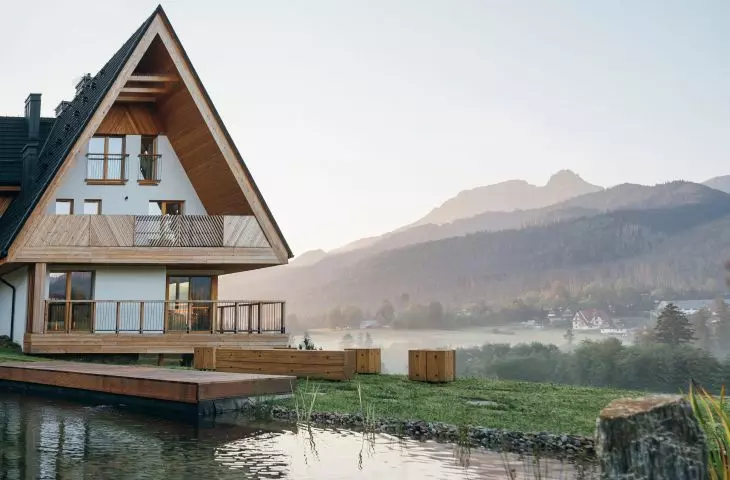Enthusiasts of relaxation in the mountains can already plan their vacations in the newly built Enclave of Glades - a complex of vacation homes located near the Koscieliska Valley. Behind the design of the eight buildings with apartments for rent is the INDO Architekci studio, which placed great emphasis on ecological and economical solutions and references to the traditional architecture of the region.
The architects have paid great attention to detail
Photo: Bartek Pawlikowski © INDO Architekci
TheGlade Enclave is located on a south-facing sloping plot of land with a panoramic view of the Tatra Mountains. This location became an inspiration for the architects, both in terms of functional-spatial solutions and the architecture of the buildings themselves. The eight, three-story buildings, which house seventy-two apartments, were designed in a dispersed layout. Each apartment is equipped with a kitchen with dining area, bedroom, bathroom and living room.
Organic pathways allude to mountain trails
Photo: Bartek Pawlikowski © INDO Architects
The whole is connected by a network of softly shaped paths, their character and surfaces allude to mountain trails. Individually designed elements of small architecture along with places for recreation and rest, lack of fences, naturally shaped greenery create a space conducive to spending time surrounded by nature, the designers from INDO Archtekci add.
The architects referred by the form of the buildings to the traditional architecture of the region
photo: Bartek Pawlikowski © INDO Architekci
architecture inscribed in context
The architects referred by the form of the buildings to the traditional architecture of the region, but gave it a modern dimension. The masses of the houses have been simplified by closing the eaves in the gable walls, and the wooden terraces protruding to their depth create a single form with the volume of the roof. Walls covered with plaster in a shade of warm white correspond with wooden elements of the facade - balustrades, gable wall frames, window and door woodwork and eaves soffits. The roofs are covered with black-colored metal tiles imitating shingles, and stone foundations of broken sandstone cut off the first floor.
first floor plan with surroundings
© INDO Architects
Importantly, the entire site was designed in the trend of sustainable development. In addition to high aesthetic and material qualities, the investors' goal was to create a site suitable for maintenance-free operation.
Black tile roofs imitate shingles, while stone foundations of broken sandstone cut off the first floor
Photo: Bartek Pawlikowski © INDO Architekci
conversation with INDO Architects
Dobrawa Bies: We're talking about your new development, the Glade Enclave. Looking at the architecture, one can see that you paid great attention to details - the wooden elements of the buildings' facades were made with great precision. Please tell us about the workflow.
INDO Architects: From the beginning of the work, we were guided by the idea of creating modern and functional architecture inscribed in the context. We didn't want to pretend to be regional architecture, but at the same time to create objects that are well embedded in the place and the environment. The key theme became the form and proportion of the buildings, for which the guidelines are the provisions of the local zoning plan and the appropriate detail. The search for detail accompanied us during numerous trips to the Podhale region. Decorative motifs designed on the facades were transferred directly from Podhale barns. The use of natural materials such as wood and stone give the buildings a traditional character. At the same time, thanks to the use of modern building materials, the buildings are functional and energy-efficient.
The wooden terraces protruding to the depth of the eaves create a single form with the volume of the roof
Photo: Bartek Pawlikowski © INDO Architekci
Dobrawa: I'm curious what requirements did the investor set for you?
INDO Architects: The task set by the investor was to create a traditional architecture that meets modern requirements, regarding energy efficiency and functionality. Thanks to the investor's attention to respect for the environment and the landscape, we managed to create a modern design firmly rooted in regional architecture. The method of heating the buildings and preparing hot water is based entirely on a central system of ground source heat pumps. The drilling of more than a hundred boreholes made it possible to supply the investment with a completely clean and relatively cheap source of heat. Traffic has been removed from the space between the buildings, which increases the safety and comfort of the premises.
Decorative motifs designed on the facades were transferred directly from Podhale barns
Photo: Bartek Pawlikowski © INDO Architekci
Dobrawa: Designing in mountainous areas differs from those in other areas, such as urban areas. What challenges did you face?
INDO Architects: When designing in mountainous regions, you have to take into account local weather conditions. The very form of the buildings, as defined in the provisions of local zoning plans, is dictated by local conditions. Steep roofs, eaves overhangs or stone foundations, in addition to aesthetic qualities, play an important functional role. They make the building resistant to frequent precipitation and melting snow, protect facades or improve the energy efficiency of buildings. Ground conditions are also much more difficult than usual in cities. Stony soils and frequent groundwater require the use of appropriate construction techniques. Another challenge is the shorter construction season.
Dobrawa: Thank you for the interview.
Black metal tile mimics shingles
Photo: Bartek Pawlikowski © INDO Architects


















































































